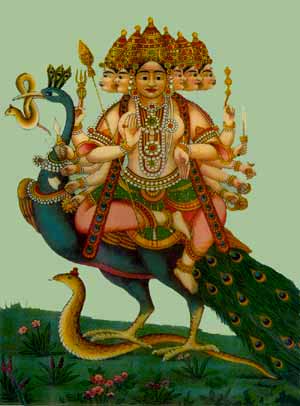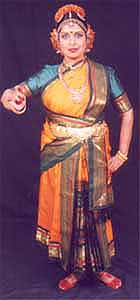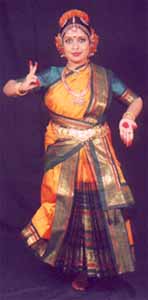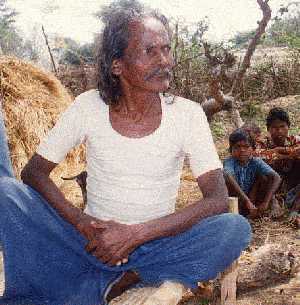
|
|||||||||||||||||||||
|
| |||||||||||||||||||||
Legends of Kārttikeya in Puruliya ChauProf. (Smt.) Malati Agniswaran
1.1 IntroductionActs of worship in the different traditions of Hinduism are processes of diverse sets of rituals in different regions and communities of India. Since the ancient, dance and music have played important roles in religious worship in India. Ample evidence for this is available in the Cankam period of Dravidian civilisation. In the Tamil epic Cilappatikāram, details are given of such modes of worship known as Vēttuvavari, Āycciyar Kuravai, Kunrak Kuravai, etc. Thus a painting on the wall, a drawing on the floor, a song or a dramatic enactment - any of these may be an act of worship. In some cases, the art expression is itself a part of the ritual - as in the case of the drawing of the image of Bhagavati in the drama form of Mudiyettu, or the songs of the devadāsī-s in the temples, or the song and dance in Vēttuvavari. In other words, the art expression is a eulogy of a deity and seeks to create a religious feeling in the artistes and the spectators, all of whom are devotees. Whichever may be the case, the art expression serves to recreate through the audio or visual mode, the varied legends of the deity, which are a part of the rich and variegated oral traditions of the country and therefore have not been available always in written texts. In the past, at some point of time, some of these narratives have been written as religious texts known today as the purāna-s. A purāna is not a unilateral account of the legends of a specific deity, but is itself a composite narrative combining a number of tales or folklores of a particular region and community. Thus, there maybe more than one purāna pertaining to a deity and each of these purāna-s may differ from the others in varying degrees. In the instance of Skanda Purāna (Sanskrit tradition) and Kanta Purānam (Tamil tradition), there are major differences in the narratives. Sanskrit had become the language of the scholars at a time when it had gained great ascendancy. Even texts derived from Tamil traditions were written in Sanskrit language. Thus we find a version of Şrī Skanda Mahāpurāna written in Sanskrit, wherein the narrative follows the Tamil legend and account of the deity. Conversely, there is a Tamil text from the Cankam period of Tamil civilisation, namely, Pattup Pāttu, where the account given of the legend of Skanda is that of the Sanskrit tradition of the North. One of the important differences in the legends of the North and the South of the country is that, in the northern tradition, Kārttikēya is born to kill the demon Tārakāsura and his brothers. In the Tamil legend, Kārttikēyar is born to kill the two demons Cūran and Patuman, who are conjoined into one form and are known as Cūrapatuman. In the Tamil legend, there is Tārakāsuran, but he is one of the younger brothers of Cūrapatuman. A second difference is that in several of the North Indian traditions, Skanda is the elder brother and Ganēsa is the younger one, whereas, in the Tamil legend, Ganēsa is the elder brother and Skanda is the younger one. The third major variation is that, in most of the northern legends, Skanda is a bachelor and Ganēsa is married, while in the Tamil legend, Skanda has two wives and Ganēsa is a bachelor. Even if we refer to the legend of Skanda as prevalent in the northern Sanskrit tradition, the narrative may be seen to vary from one region to another, as the local legends of the different communities of the region bind themselves to the main narrative. The more popular name of Skanda, prevalent in most regions, is that of Kārttikēya, because the common element seen in all the accounts of the birth, is the subsequent nurture of the god by the Krttikā-s, from whose association the name is derived. The present paper analytically describes the legend of Kārttikēya as is prevalent in the Purulia district of West Bengal, and specifically as the legend is presented in the Chāu dance performances of the region. 1. 2 - Purulia - The region and the artistesPurulia is a triangle of upland along the western border of West Bengal. The language of the people is Bengali. From Tatanagar in Bihar, one road goes to Ranchi and another to Purulia. The border between Bihar and West Bengal, has to be crossed to enter the Purulia diistrict. Purulia originally belonged to the district of Manbhum in West Bengal. The name Manbhum has been derived from Vardhamana, the former name of Mahāvīra, who is the most prominent among the initiators of Jainism. Mahāvīra lies in rest at the Pārsavanātha Hill adjoining the district of Manbhum. Purulia was the name of the district-headquarters and a subdivision of Manbhum during the formation of the district of Manbhum. At various times during the rule of the British and then in independent India, this district belonged to West Bengal or to Bihar. It was in the year 1956, that the district of Purulia was formed. It is the youngest district in West Bengal so far. The district of Purulia is economically backward. The common people are generally poor but they are very vigorous and hard-working even without adequate food.
Guru Gambhir Sinh Munda holds a venerated position as a guru among the artistes of Puruliyā Chāu today. Guru Gambhir Sinhji has been honoured with the title of Padma Şri by the Government of India. According to Guruji and others, their community is known as Bhumij and their family name is Munda. Many of them are landowners. They have been Chāu artistes for several generations. Some of them are chiefs of their community. The Mundas hail from the Bhumij community, but are today Bengali speaking Hindus. The only religion they know is Hinduism. The Bhumij or Munda who are performers of Puruliyā Chāu also known as Chāu Nāca, are those who live in Manbhum region. The Bhumij, were in the distant past, warriors. Dance arising out of body kinetics cannot lie. The muscle set initiated by one's lifestyle and origin, lasts for several generations in the community. The martial background can be seen to exhibit itself in the very fundamentals of the technique of Puruliyā Chāu. 1.3 - Performance of Puruliyā ChāuPuruliyā Chāu is danced in a very small geographic region. The Chāu is a belt - a dance belt that girdles part of the eastern region of India. It comprises three contiguous states. each of which has a small sequestered pocket that cloisters the art and after which the tradition in the region is named - Seraikellā Chāu in Bihar, Mayūrabhañja Chāu in Orissa, and Puruliyā Chāu in West Bengal. All three Chāu forms are danced by men only. The Seraikellā and Mayūrabhañja versions seem to have common roots. The Puruliyā form, as a dance, seems to belong to a different realm altogether. When Purulia was part of Bihar, no research was done on the people or their art forms because the region belonged to Bengal; West Bengal did not do anything for the region because it belonged to Bihar. The Chāu artistes say that, it was only from the seventies onwards that their dance form gained recognition outside Purulia. The dance form, as it exists to this day, has not been supported by the patronage of any individual, but is the product of the community as a whole. It is not known whether Puruliyā Chāu had enjoyed the patronage of any rājā or feudal chief. The participants do not recall the names of any of their patrons in the past and they do not have any even now. Yet they have been continuing the practice for generations. The participants know their immediate ustāda-s only and beyond them nobody else. The ustāda-s or the trainers are in most cases, hereditary. Therefore, it is extremely difficult to know how, when and where, this form of dance originated. The intricate āngikābhinaya suggests that at one time they may have been bare-bodied. In recent times, several of the costumes have been modelled on the costumes of the traditional theatre form of Bengal, namely, yātra, which itself had been influenced by the professional theatre of Calcutta. This was facilitated by the fact that at one time mythological plays were popular in urban professional theatre of Bengal. The dancers of Puruliyā Chāu use masks for most of the characters. The masks, made of paper mache, are decorated with tinsel decorations to keep them light to facilitate the dancers' movements. In the case Kārttikēya's mask, a number of them in differerent sizes are required, to show Kārttikēya as a child, a young boy, and then a youth. Kārttikēya was a youth when he killed Tārakāsura. The colour of Kārttikēya's mask is yellowish orange and fair, for he is a benign deity. The colours red and black are generally used for asura-s. Indeed, as masks are costly, the mask of one asura is used for representing other asura-s as well. The same mask used for Şankacūra is also used for Tārakāsura, although the legends pertaining to the two demons are quite different. The main theme in most of the dance items in the repertoire of Puruliyā Chāu, is that of battle. There is no emphasis on shrngāra, except in the Rādhā Krsna dance. The sole message in Puruliyā Chāu is: good triumphs over evil. In all the items there are two opposing forces, involved in mortal combat - Rāma against Rāvana, Indra against Şibi Rāja, Abhimanyu against Duryodhana, Dusāsana, Drona and others, Nārāyana Gayālura, Kārttikēya against Tārakāsura, Arjuna against Şiva disguised as a hunter, Durgā against Mahisāsura, Cikurāsura, Şumbha-Nisumbha and a host of other demons - such are the themes, drawn from the epics and the purāna-s, that contribute to the repertoire of this art form. Except for a few narratives where Durgā is the protagonist, most of the characters are male. Durgā too is seen here in her fierce aspect only and her dancing is agressive, martial in spirit, for she is in a battlefield. As fighting dominates there is little opportunity for individual artistry. The performance cannot portray any movements that are sensitive or subtle. All movements are forceful and masculine. All through the performance tension is heightened, and there is hardly a movement of peace or calmness. The power of endurance of the dancers deserves appreciation, as dancing with masks makes breathing difficult and also vision is limited. Consequently the dance items are of relatively short duration. A night's performance may offer twenty-five or more items, which may or may not be related in their narrative aspect. A presentation of Puruliyā Chāu lasts all night long. The opening item is always in honour of Ganēsa. . The performance takes place generally in the open, with audiences on all four sides. A corridor is provided through the seating arrangement, which apart from helping dramatic entries and exits, also serves occasionally as a subsidiary performing area. The musicians stand on one side with dhāmsā-s or huge kettle-drums, dholaka-s which are smaller drums, and sēhnāī like pipes and provide music which enhances the impact of the dance. A sūtradhāra makes his appearance between items, and in verses, offers a narrative to introduce or link the episodes. Most of the dances are performed by two dancers or are group compositions. Often the finale is a tableau with imaginative poses and formations. 1. 4 - Derivations from Classical Dance ModesThe technique of dance in Puruliyā Chāu Nāca reveals a rich grammar of body movements which have been mentioned in the texts of classical dramaturgy and dance. The basic stances of Ksipta with the knees turned out and bent at right angles, is maintained in the dance movements. The various leaps, circular movements, walks etc. are similar to those which are described in texts such as Bharata's Nātya Şāstra (NS) and Nandikeshvara's Abhinaya Darpana (AD). The form of Chāu Nāca appears to have lost its status in the hierarchy of classical dances in present times. But it certainly reveals that in the past this dance tradition must have had a high standing in this region. Art forms such as Puruliyā Chāu have had a close association with the religious traditions of the region and preserve such traditions within the community through their performances. Indeed, greater research is called for to find out in detail the common features shared by Chāu Nāca and other classical dance forms whose dance techniques are also in accordance with the principles of dance movements described in the same traditional texts. A brief analysis of some of the body movements prevalent in Chāu Nāca and their corresponding movements (and their names) as stated in the classical texts named above are given to elucidate this point. The dancers of Puruliyā Chāu themselves are not aware of the connection between their body stances and movments and the descriptions of the same that are given in the texts. The names of body movements have been identified from the definitions given in the traditional texts of NS and AD. (The quotations from the texts are restricted to those that are relevant to the movements prevalent in Chāu Nāca) This section of the paper will be demonstrated.
|
There are no rituals performed for Kārttika in the houses. There are rituals for Durgā, Şiva, Mānasā et al. in homes. There is no animal sacrifice or balī for Kārttika pūjā whereas, for Durgā pūjā there is sacrifice. In Kārttika pūjā, in some instances, during Kārttika Sankrāntī, an image is made of the deity and worshipped. But after the ritual, the image is immersed in water and visarjana is done.
Kārttika a bachelor god. If women performed rituals and touch his image, then his bachelorhood would be tarnished.
The legends of the region of Purulia pertaining to Kārttikēya are seen in the themes of Chāu Nāca. These legends are derived mainly from the puranic legends of Skanda. It must be noted that as Chāu Nāca is performed as a ritual during the worship of Şiva, and as Durgā is the main deity for the Bengalis, Kārttikēya does not emerge as the main protoganist in the narratives.
The first item in Puruliyā Chāu is on Ganēsa, called Ganēsa Vandanā. It is in this item generally that Kārttika also makes an appearance.
Two narratives of Ganēsa Vandanā are performed in the Bagmundi area.
Kārttika comes in and gets angry with Parasurāma for behaving rudely with his brother. He tells Parasurāma that, if his brother did not let him in then even he is helpless. Again a fight ensues, this time with Kārttika, and he
is defeated by Parasurāma. Hearing the sound, Şiva and Durgā come out. Parasurāma tells Şiva that he had come to see the Lord, but that these two did not allow him entry. Şiva and Durgā bring them all together, and in the end they all dance together.
As the main theme of Puruliyā Chāu is war, Kārttika is a character invariably portrayed in the episode of his battle with Tārakāsura.
The Jhalda group presents an item depicting the birth of Tārakāsura, and the burning of Manmatha by Şiva. The appearance of Kārttikēya is not shown in the dance. Arsha follows mainly the items which are presented by Bagmundi. These are, the fight between Kārttikēya and Şankacūda, and yet another of the killing of Tāraka by Kārttikēya.
There is yet another episode of fight between Krsna and Kārttikēya. The legend goes thus:
Now the distressed dēva-s go to Visnu for help. Visnu knowing the truth, sends them to Şiva. Şiva hears the pleas of the dēva-s and promises to slay Şankacūda. Kārttikēya and Ganēsa, who are the overall generals of the army, went to Şiva, fully equipped with weapons, ready for war. Then ensued the great war. Kārttikēya, the slayer of Tāraka, and Kālī, create great havoc. But Kārttikēya falls down defeated and Kālī takes him to Şiva. Then Kālī fights, but is sent back by a celestial voice.
When Şiva goes to battle, the dānava-s bow to him. The battle lasts for 100 years. Şiva could not kill him, for as long as Şankacūda wears Visnu's amulet, and Tulasī maintains marital fidelity, he has neither death nor old age. Visnu, in the guise of an old man, begs away Şankacūda's amulet, and in the guise of Şankacūda, has sexual relations with Tulasī. Now Şiva slays Şankacūda. That is why it is said that, except for Şiva, the holy water from the conch is sacred for all gods. As in the themes of Ganēsa Vandana, here too, Kārttikēya fights with the demon, gets defeated, and it is Şiva who brings back peace.
In Chāu Nāca, the story of Kārttikēya is presented thus:
The performance opens with dhola and dhumsā players standing in the centre of the arena and playing. Thereafter, they move to the side. These drummers are very mobile. Each time that a character has to enter, they go to the entry point upstage centre, play there and then return. Even in between the performance, they get up and play. On the other hand, the singer and the sahnāī player remain in their place.
Though Ganēsa is a benevolent god, the artiste performs a great deal of tāndava. There are different jumps and spins:
- the body jumps from the position of āyata mandala (AD), in ākāsa bhramarī (AD);
- from āyata mandala (AD) position, one leg is lifted, takes the body in a circle and then sits flat on the floor with the knees touching each other; and
- circle is taken, and then sitting on the floor with two knees touching each other and facing opposite directions.
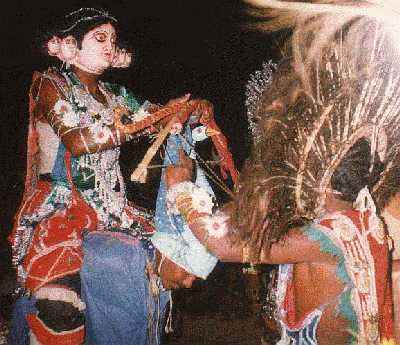 |
Şadanana seated on a peacock. The devas gift him astras. |
Then comes the entry of Kārttikēya. The narrative song on his entry is:
"Kārttika mahāvīra krodhē kampē thara thara
Kārttika brave one in anger trembles
asicēn mayūra vāhana.
coming on the peacock vehicle."
Kārttika takes the position of pārsva sūcī mandala (AD) and looks around. Then standing straight with the two feet apart, looks violently from side to side. He lifts his leg in atikrāntā cārī. Then the legs assume the ālīdha and pratyālīdha sthānaka (NS), and move in that position. Then the dancer sits flat, takes the position of samasūcī mandala (AD) with the knees raised and takes leaps. He performs ulphā movements. Then he sits in vajrāsana (yoga). He looks around violently, takes a circle and sits back in vajrāsana.
Ganēsa enters, both dance together. Kārttika moves in kuñcitapāda (NS) with knees in ksipta. In his left hand he has the dhanusa and in the hand musti hasta is held in sausthava. Both players perform tāndava movements alternatively, face each other and hold hands.
Now Mahisāsura enters. His mask is green and he has a horn on his head. He fights with Ganēsa who is defeated. Durgā enters with a lion. She holds a trisūla and talavāra. A face to face fight between Mahisāsura and Durgā ensues. Durgā kills Mahisāsura. Then Kārttika enters. Then there is a final freeze. Durgā is in the centre with the lion behind her. Kārttika and Ganēsa are on either side of her. They take a circle in the same form and exit. This is the beloved story of all Bengalis, that of Durgā and her vadha of Mahisāsura. Kārttika being Durgā's son, plays a minor role, and he cannot vanquish the demon.
Kārttika janam - The main item.
The complete narrative cannot be shown through the performance. Much of the narrative is presented through traditional songs, which are sung in the beginning or between episodes. The narrative which is the background to the main legend and part of which is not shown through the performance is as follows:
The dēva-s, suffering under the torture of Tāraka, go to Visnu for protection. Visnu realises through his jñāna sakti that the daitya can be killed only by the son created by Şiva. No one other than Şiva's son can kill Tāraka. Visnu also tells the dēva-s that as the daughter of the mountain, Ādi Mātā has taken an incarnation. Şiva and Durgā should get married. The dēva-s are told that Kārttikēya will be born of this union and he should be made the dēvasēnāpati. The asura can be killed only by Kārttikēya.
Hara and Gaurī get married. In the course of their play, the Mother could not bear the seed of Şiva and it is thrown into Gangā. Gangā also could not bear the seed and deposits it in the sara vana on the banks of the river. Thus Kārttikēya was born.
The six damsels of the moon were playing in the water. They see the child and are surprised. Of them, Krttikā first lifted the child and from her the child was given the name Kārttikēya. Each woman wanted to nurse the child and so he became six-faced, the Sadānana. The women knew through dhyāna or inner perception, that the child belonged to Şiva and Durgā. So they take the child to Durgā.
The gods made Kārttikēya the dēvasēnāpati. In the meantime, Tāraka's atrocities increased. With all the astra-s given by the dēva-s, Kārttikēya goes to the battle and slays Tāraka. Tāraka, in this legend, is the brother of Kārttikēya, born of Şiva's hair. On Kārttika Sankrāntī, Kārttikēya is worshipped.
The legend is presented in Chāu Nāca thus:
The dhola and dhumsā players are in the centre. The story as it is to be presented is sung in narration, during which time, there is no action on the stage.
- "suno suno sabhājanahear oh hear people of the audience
Kārttikēr janma vivarana
details of Kārttika-s birth
āvatīrna sikha bar āsan
came he seated on the peacock
sāgara tīrē sara bāganē
by the seaside in the forest of reeds
prakata holēn hrsta manē
appeared he with a heart of joy
sethāy krīdā rata candrēr ramani gāna
there were playing the maidens of moon
suno suno.
hear o hear."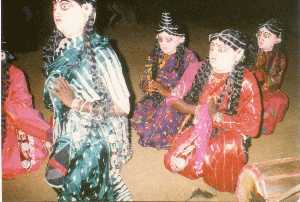 Six Krittika maidens.
Six Krittika maidens. - "sundara sisurē hērē harasita antarē
seeing the child of beauty they felt happiness within
cumbana karēn sisura badanē
they showered kisses on the body of the infant
ēka sangē chai jana sthana dēna sisurē badana
together six women gave their breasts to the infant
ai kāranē hoilēn Sadānana
this was why he was called six-faced one
suno suno.
hear o hear." - "dhyānē tē janilēn vārtā
with concentration hear this tale
Harē Gaurī mātā pitā
father Hara and mother was Gaurī
loi gēlē Kailāsa bhuvana
they took him to their home at Kailāsa
vārtā jānī dēvaganē Tārakāsura vidhanē
knowing this came the celestial beings, for the destruction of Tārakāsura
tārē sēnāpati karēn baran
you shall be accepted as the Lord of the army
suno suno.
hear o hear." - "Tārakāsura mahavīra digvijayī tīnapura
great warrior was he, Tāraka demon, victorious over three worlds
dēvaganē karilo dalan
vanquished he the celestial divinities
sunī vīra cūdāmani divya astra sandhānē
hearing of this the Brave Jewel took his divine weapons of war
ranachētrē jāna Sadānana
went to the battlefield, Sadānana
suno suno.
hear o hear." - "dhanura bāna loyē hāthē
holding the weapon of bow and arrow in his hand
jujhēna asura sāthē
fought he with the weapon
rana dēkhī kāmpē tribhuvana
the three worlds trembled seeing the war
astraghātē jara jara
got injured by the showers of the weapons
hoilēn Tārakāsura
the demon Tāraka
Kārttikēr hātē hoi nidhana
vanquished was he at the hands of Kārttika
suno suno.
hear o hear." - "niskanthaka dēvagana hoyē ānandita mana
freed of worry, the celestial beings became full of joy
gēlo jathā mayūra vāhana
went off the One on the peacock
Kārttika Şankrāntī tithī pūjilēn sudha bhakti
on the day of Kārttika Sankrāntī is worshipped with pure devotion
modēra nartya nātyēr ēi vivarana.
this be the detail of our dance drama."
Şiva and Durgā are in Kailāsa. They dance. A traditional song known as jhumura is sung in the background.
"Kailāsētē Hara Gaurī karē navonamana
in Kailāsa Şiva and Gaurī are worshipped together
sarva dēva āsēna tathāy tapasya karana."
all celestial beings come there to do penance."
The dance:
The dēva-s come to the deities. Many dēva-s come and while dancing move around. The dēva-s are harassed by Tārakāsura. The dance movements are violent though they have come to speak of their troubles. Gods are harassed by Tārakāsura.
Brahmā, Visnu, and Indra come on their respective vāhana-s. Kārttikēya comes on elephant. (The 'elephant' is made with two dancers inside a sack covering) All exit. The narration is sung in the background.
"chala karē prāna harē nilo kālā cha jani rē
āmārē lāgē ēkala pata bosota kadam tāla
kotha ranga karē nilā kālā cha jana."
The dance:
The six stars (women) enter and they go in a circle and dance. They see a child under the saravana (reed thicket made with branches and leaves). The Krttikā-s pick up the child. They pass the child to each other. Then they exit with the child.
Kārttika enters the stage now as a boy of eight of age. Then he exits. Next enters Kārttika as a fifteen year old boy. He wears a mask of Sadānana with six faces. He dances and exits. These multiple entries of Kārttika establish his growing up.
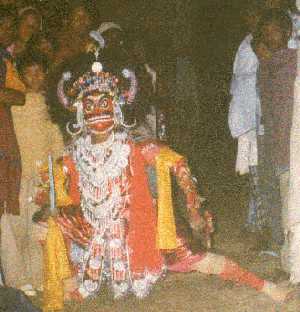 |
Tarakasura with red mask, takes his entry |
All the dēva-s come to Kārttika with folded hands. Brahmā gives him mayūra vāhana. The peacock comes on the stage (played by two dancers). Kārttika sits on the peacock. Each of the dēva-s gives him his astra. Kārttika gets a bow, arrow and sword. He exits sitting on the peacock.
Now comes Tārakāsura's entry. He comes rushing forward. Then he somersaults, falls down on each side, and gets up. He has a sword in hand. The asura wears a red mask. He sits in the position of grdhrāvalīnaka karana (NS), circles and changes to the other leg. Sits alternatively on floor. Then he turns cartwheels. He performs ulphā-s. All the dēva-s fight with Tārakāsura. Tārākāsura is after Saci whom he captures. Now Kārttika enters and frees Saci and her friend.
An older Kārttika enters. He wears a mask with a single face. The asura and Kārttika fight with swords. Both fall and get up. Then they hit each other, fall and rise. Then they fight with gadā-s. Tāraka falls but rises immediately. Then, hands on each other's shoulders, they do mallayuddha. Again Tāraka falls but rises. Then fighting, both fall and get up. They pick up dhanusa and bāna. tāraka is hit by an arrow and dies.
All the dēva-s come to Kārttika and bow to him. Then Kārttika is worshipped. Kārttika is seated on mayūra vāhana and all exit. The performance concludes with a virtuosic solo dance by the ustāda Kirod Sinh Munda. It is a nrtta piece.
In the performance, it can be seen that even the benevolent dēva-s, even deities Ganēsa and Kārttikēya in their benevolent forms, move their necks, etc. in a jerky manner to extremities, that are appropriate for violent or aggressive characters, in other styles of dance. Probably, this indicates their characters as warriors. Actually, as Puruliyā Chāu essentially depicts wars, there are practically no movements which are soft, indicating a benign mood.
10. Yet another performance is that of Kārttika Krsna Yuddha. The text is as follows:
Krsna Kārttikēr Juddha . . .
- "sonita isvara bānērduhita
Usā nāmē dhonira sakhī Citralēkhā
marma alāpana karē
syāmala kisora rūpa manohara
sapanē bolilāma tārēgo
bolo bolo sakhī upāyana dēkhī
kērmonē pāyibo tārēgo." - "Citralēkhā sakhī dēkhē khodi pati
sē kisora hoy Şrī Krsnēra nātī
Aniruddha nāma dharēgo
ghora nisākālē māyājoga bolē
aniya milālo tārēgo
bolo bolo." - "harasita Usā nagarē bhētilo
Şyāmērē bāmē jano Rādhikā sajilo
Citralēkhāra mana horēgo
oti gopanētē gandharva mātē
bibāha dilo dhoni tārēgo." - "vārtā pēya Bāna rājāra gharonī
Bāna pratī kahē ati mrdubānī
harilo mor kanyārē
vārtā pēya Bāna krodha kāmpomana
sondhana karē kumārē." - "Aniruddhē dhorī bandī karē tārē
silā cāpa dilo bakhēr porē
dēva rsi asi dhēkhēgo
rsi Dvārakāya giyā Krsnē sambhodiyā
pracārilo sēi kothāgo." - "vārtā pēyē tavē yadukula muni
Pradyumna ādi joddhā āra holopānī Balarāma
uttarilo bāna purēgo
binatānandanē Gangābāri ēnē
Agni nirvāpana karēgo." - "Krsna sanyo dēkhi Bāna
daityēsvara sajo sājo rānē
bolē sabhākārē sajilo Kārttika bīra
juddha vārtā pēya Şiva Durgā dhēyē
ranasthē āgu sarēgo." - "astraghātē Bāna asthira hoilo
cakra liyē prabhu bāhu kāti nilo
abasista dui rāhēgo
Şrī Krsno Kārttikērē dēkhī juddha tē nibārilēn Gaurī Harēgo."The narrative is as follows: (In the dance performance, the narrative begins with Aniruddha harana. )
The daitya is the king of Şonitanagara, and a great devotee of Şiva and Pārvatī. Their jamātā was Agni, who had given a boon to Bāna that he would always protect the asura's gadā and that no one will be able to conquer him.
Bāna's daughter Usā was of marriageable age. With her is her companion Citralēkhā. Usā in a dream, sees a man and gives her heart to him. She tells her friend about her dream and wonders when she will meet him. Citralēkhā could make portraits of everything in the three worlds. She does so and she tells her friend Usā to identify the person whom she had seen in her dream. Usā sees the portrait of Aniruddha and feels shy. Citralēkhā understands that this was the man Usā had fallen in love with. She takes the help of māyā and abducts Aniruddha to Şonitapura. By Gāndharva rites, Usā and Aniruddha are married. Bāna's wife comes to know of this.
Bāna gets angry and imprisons Aniruddha and places a stone on his chest. Nārada comes to know of this. He goes and informs Krsna, who is looking for his grandson.
Nārada sees the plight of Aniruddha. Bāna asks Nārada who the boy was and Nārada tells him that the prisoner is Krsna's grandson.
On being informed by Nārada, Krsna with Balarāma and Pradyumna, flies on the Garuda to Bāna's kingdom. On reaching the kingdom, Krsna sees the fire burning around the fort. . Garuda brings water from the Gangā in his mouth, which puts out the fire. Then they are able to enter the fort.
They ask Bāna to send Usā and Aniruddha with them. But Bāna gets angry at this and then the battle starts. Bāna is angry that his daughter has been seduced and that it was Krsna's grandson who caused all this trouble, and now they were asking for bidāī. So he sends his army for the battle. Krsna fiights with Bāna's sēnā, but they could not face Krsna for long. Then Şiva comes to Bāna's side and fights. For the purpose of the battle, Şiva creates sivajvara, a fever which fights with Krsna and surrounds him. Krsna now creates visnujvara, and there is a confrontation beween the two jvara-s. Visnujvara is more powerful, and seeing this, Şiva himself comes to the battle. Kārttika comes on his mayūra. When Krsna lifts his sudarsana to kill Kārttika, Durgā appears there. She stops the battle and brings peace.
The religious or ritual context helps to continue art traditions and sustain them in several instances. The changes that modern lifestyles have brought in, have also affected Chāu Nāca form. There is less of an acquaintance with the myths and legends in the artistes and the audiences of contemporary society.
The traditional artistes preserved the folklore and legends of the deities prevalent in their communities and regions. When the traditional arts begin to die owing to social neglect, this also leads to distortion of the traditional legends.
The following legends are being presented in modern performances of Puruliyā Chāu.
- A variation in the invocatory item portraying Ganēsa, Kārttika and Parasurāma - Parasurāma wishes to go for gurudarsana. But he is stopped by the gate keepers, Ganēsa and Kārttika, who enter dancing. Then they and Nandī fight with Parasurāma. In this version, Kārttika defeats Parasurama. In the same item of Ganēsa Vandanā, Mahisāsura also comes in and is killed. Then Durgā intervenes and pacifies them all.
Parasurāma and Mahisāsura are brought into the same battle and both are defeated. Durgā is not shown as the slayer of Mahisāsura. Even knowledge of Tārakāsura and the tale of the battle between Kārttika and Tārakāsura is not known to some of the modern teachers of Chāu Nāca. All these errors are due to lack of knowledge of traditional legends.
In the performances of the Chāu Nāca group in Jhalda, can be seen themes that are contrived, and have not been derived from any of the legends of the region, or even from the mainstream of the traditional legends.
- Ganēsa enters with his usual Bengali costume and dances after the usual introductory song in praise of the elephant-headed god. Then Nandī enters with a pair of bullocks, with the intention of cultivating land. Immediately Rāvana enters, followed by a hunter, and they engage themselves in a combat. Nandī joins the fight against Rāvana. Şiva enters and pacifies them all. Rāvana surrenders to Şiva. All of them exit. Immediately about half a dozen ghosts enter, followed by Kārttikēya and Durgā. The latter fight against the ghosts. Visnu with a cakra in his hand enters and pacifies them all. The fighting ends and thus the scene ends.
- After the invocation to Ganēsa, he enters. Ganēsa dances for some time, and after an introductory song on Kārttikēya, he also enters and joins the dance with Ganēsa. This continues for some time and another two
lines of lyrics are sung describing the killing of Indrajīta by Laksmana. Almost immediately, enter Rāma and Laksmana. After a short dance they all sit down, and Pramilā, wife of Indrajīta enters without a mask. She gives an exhibition of dance of a very vulgar type in the style of khēmtī or dance of the 'dancing girls' of the area. Hanumān and Rāvana enter and they immediately begin to fight. Those who were sitting till then, stand up and engage themselves in a fierce fight against Rāvana. By this time, about eighteen characters are in the acting area. Lastly enter Şiva and Durgā and a number of rāksasa-s and a fierce battle starts between the two parties - the celestials and the demons. The scene ends in great excitement and confusion.
1. 7 - Conclusion
- The concept of Kārttikēya in Purulia and the adjoining regions follows in the main, the legend of Skanda as prevalent in the purāna-s of the Sanskrit tradition.
- Therefore, Kārttikēya is a war-god and is not worshipped generally by householders; nor are there any temples dedicated to Kārttikēya in this region.
- As traditional Puruliyā Chāu Nāca form presents the concept of Kārttikēya as derived from the puranic tradition, the performances are restricted to the legends of Kārttikēya, Ganēsa, Şiva, Pārvatī (mainly in the form of Durgā), Gangā, the Krttikā-s, and Kārttikēya's fight with Tārakāsura. The legend pertaining to the marriage of Kārttikēya with Dēvasēnā has been mentioned in some texts of Sanskrit tradition, but briefly, and has not entered the themes of Puruliyā Chāu Nāca.
- The legend of Kārttikēya and his battle with Tārakāsura is accepted as the main narrative of the deity and great importance is given to this narrative of Kārttikēya in Chāu Nāca, to the extent that there are multiple entries of Kārttikēya in different stages of his growth from childhood to youth, a feature not prevalent in any of the other dances in the repertoire. To play the role of Kārttakēya is the ambition of every young Chāu dancer.
- It is only in the battle with Tārakāsura, that Kārttikēya wins the battle. In all other battles he is defeated.
- The importance of Kārttikēya in Puruliyā Chāu is only due to the fact that the dance tradition is offered as a ritual to Şiva, and Kārttikēya belongs to the Şiva pantheon. Also, Durgā is the chief deity in the region of Bengal, and therefore, Kārttikēya accompanies her. But the battles are won by Şiva or Durgā and not by either of their sons.
- A variation in the Skanda legend in Chāu Nāca is that, Tārakāsura is also said to be a son of Şiva.
- There are a number of tales associating Sasthī with Kārttikēya in this region. But none of them are depicted in Chāu Nāca.
- The association of Kārttikēya with Sūrya and therefore with Sankrāntī is also given great importance in this region, but there is no mention of this aspect in Chāu Nāca.
- The significance of the paper does not lie only in the narration of the legends of Kārttikēya in the Purulia region, and in Puruliyā Chāu Nāca. What is more significant is the emphatic acceptance that the traditional kinetic art forms have played a highly significant role in the preservation of the legends and folklore of the various communities of the country through the oral traditions.
- In the case of those art forms that are performed before audiences as part of rituals, their aura of sanctity has given them an opportunity to communicate to their audiences the tales from the epics and the purāna-s and the ethical messages contained therein.
- In the changing social fabric of the present times, these arts have lost their places and are slipping into oblivion.
- Artistic freedom, innovation and experimentation must lead to new concepts, new themes. If such changes are directly related to traditional themes, then artistes may be led or be tempted to present distortions of ancient legends. In several instances of innovative art expressions, there is a deliberate attempt to 'use' the traditional legends because they lend an Indian flavour to a presentation, and yet mutilate them solely with the intention to create sensationalism.
- It is in cognisance of the role of the traditional artistes and the art forms, in the preservation of the religious and cultural traditions of the country that, it has become necessary to record the traditional artistes and their communication of their oral traditions in every part of the country. This paper is such an attempt.
Bibliography
- Mohan Khokar, Traditions of Indian Classical Dance (New Delhi: Clarion Books, 1984).
- Ashutosh Bhattacharya, Chhau Dance of Purulia (Calcutta: Rabindra Bharati University).
- S. C. Bose, Geography of West Bengal (New Delhi: National Book Trust, 1968).
- Kapila Vatsyayan, Traditional Indian Theatre: Multiple Streams (New Delhi: National Book Trust,1980).
- Nātyasāstra, trans. and ed., Manomohan Ghosh (Calcutta: Royal Asiatic Society of Bengal, 1951).
- Abhinaya Darpana, trans., Manomohan Ghosh (Calcutta: Manisha, 1989)
(It must be clarified that the identification of these features of technique as being similar to those mentioned in the classical texts, follows from the understanding of the technical terms, as they have been studied and analysed at Nalanda Nritya Kala Mahavidyalaya. This point of clarification is necessitated by the fact that, any text on prayoga needs to be interpreted by the artiste of that discipline of art. In such cases, the interpretation of the textual import with reference to prayoga may differ in the different schools of practice and research. )
- H. H. Risley,The Tribes and Castes of Bengal, Vol. II (Calcutta: Firma Mukhopadhyay,1981).
- Srimad Devi Bhagavatam, trans. Swami Vijnanda (Delhi: Munshiram Manoharlal - 1992).
- Şiva Purāna, Rudra Samhitā, Yuddhakhanda Section V. trans. A Board of Scholars, ed. J. L. Shastri, Ancient Indian Tradition and Mythology, 2. (Motilal Banarasidas 1973).
- Lal Behari Day, Bengal Peasant Life (New Delhi: Cosmo Publication, 1984).
Personal Interviews
These interviews were conducted during my visit to Purulia in 1998:
- Guru Gambhir Sinh Munda.
- Guru Kirod Sinh Munda, Jamdih, Singhbhum.
- Gandhi Mahato, Royal Chhau Academy, Balarampur.
- Dhol player in Kirod Sinh Munda's group.
- Kirod Sinh Munda Performance. Chau. Jamdih, Singbhum .
- Tapankumar and Others, Mask makers, Chorda, Purulia,.
- Umeshkumar Pandeyji, Priest, Siva Temple. Tatanagar.
- Pujya Guruji Brahmanandji Shastri. Kali Temple. Tatanagar.
Appendix I
Nātya Şāstra
Jānubhēdāh (shank and its uses)
X. 34-40. 194-195
āvartita (turned) The left foot turning to the right and the right one to the left.
Usage: In jester's walking.
nata The knee bent.
Usage: In assuming standing and sitting position.
ksipta (thrown out) Şank thrown out.
Usage: In exercise (of limbs) and the classical dance.
Pāñcavidha Pādabhēdāh (the feet and their uses)
X,41-50. 195-196
udghattita Standing on the fore part of the feet and then touching the ground with heels.
Usage: In practice, this follows the udghattita karana and this should be applied once or more in the high or medium speed.
sama (natural) - (feet) naturally placed on an even ground. It is related to representing a natural posture.
Usage: It should be kept still in representing the natural position of the body in connection with the various karana-s, but in the rēcaka movement of the feet it should be moved.
añcita The heels on the ground, the forepart of the feet raised and all the toes spread.
Usage: It is to be applied in representing a movement with wound at the forepart of the foot, turning round in every way, foot being struck (by something) and in various bhramarī movements.
kuñcita The heels thrown up, toes all bent down and the middle of the foot also bent.
Usage It is to be used in aristocratic (udātta) going, turning to the right and vice versa and the atikrāntā cārī.
Cāribhēdāh
X. 52-54. 196
Persons practising (the cārīs) should take up simultaneously the movements of the feet, the shanks and the thighs. (For) in the movement of feet are included all the movements of the shanks and the thighs.
The thighs follow the way in which the feet are moved, and those two (limbs) constitute the cārī of the feet.
XI. 1. 197
As the cārīs prescribed by rules and connected with (different) limbs relate to one another they constitute (lit. are called) a vyāyāma (system).
From the cārīs proceed dance as well as movements (in general) and release of missiles, and (the stage) fighting (in general) should be made with the cārīs.
Hence, I shall describe the rules of the cārīs which are to be used in dance, ordinary movements and fights (on the stage).
Bhaumī Cārī
XI. p. 198
vicyavā Separating the feet from the samapāda position and striking the ground with their forepart.
utsyanditā The two feet to move in and out in the manner of a rēcaka.
Ākāsikī Cārī
XI. 29. 199
atikrāntā A kuñcita foot thrown up, put forward and caused to fall on the ground.
pārsvakrāntā One foot kuñcita and another thrown up and brought down near the side.
udvrtta The (kuñcita) foot of the aviddhā cārī taken round (the thigh of the remaining leg) and thrown up and then caused to fall (on the ground).
bhramarī A foot in the atikrāntā cārī to be thrown up and the entire body turned round (lit. the trika turned round) and the second foot to be moved on its sole.
Sthāna-s
XI. 50-71. 201-203
I shall now speak of the sthānas (standing posture) to be used in the releasing of the missiles of all kinds. (X. 49. 201)
60-62. vaisākha The two feet three tālas and a half apart and the thighs without motion; (besides this) the two feet to be obliquely placed pointing sideways. Kārttikēya is its presiding deity.
62-64. Uses The sthāna should be assumed in riding horses, in exercise, exit (from any place), mimicking large birds, practice of bending the bow and in the rēcakās (of the feet).
64-65. mandala It relates to Indra (i. e. its presiding deity is Indra). In it the feet are four tālas apart and they are obliquely placed and turned sideways, the waist and the knee are in the natural position.
65-66. Uses The mandala sthāna should be assumed in the use of weapons like the bow and the thunderbolt, riding of elephants and mimicking of large birds.
66-67. ālīdha The right foot in the mandala sthāna drawn five tālas apart (from the other foot) will make the ālīdha. Rudra is its presiding deity.
67-69. Uses This sthāna should be assumed in all acts relating to the Heroic and Furious Sentiments;duel of wrestlers and in the representation of enemies, an attack (on them) and release of the missiles.
69-70. When the right foot is bent and the left foot is put forward in the ālīdha sthāna, the pratyālīdha
pratyālīdha sthāna will be produced.
70-71. Uses The missiles made ready for throwing from the ālīdha sthāna are to be (actually) thrown from the pratyālīdha sthāna. The actor should use various weapons from this sthāna.
Nyāya-s
XI. 71-87. 203-204
71-72 There are four nyāyas (ways) of using weapons (lit. releasing missiles).
73-74 In these nyāyas arising out of various cārīs, the actors should walk about (on the stage) at (the time of) using weapons.
74-75 The nyāyas (ways) are so called because fights (on the stage) are nīyantē (carried on) with the angahāras relating to the nyāyas and arising out of them.
75-77 In the stage fight there should be no (actual) fighting, cutting or flow of blood and actual striking. The use of weapons (lit. release of weapons) should be done with its mimicry, or the cutting off (of anyone's limb) should be presented, according to rules, by the use of gestures and postures only.
Now the second text mentioned above is referred to, as follows:
Appendix II
Abhinaya Darpana
Mandalabhēdāh
260-273. 107-108
sthānaka Standing with samapāda, feet in the same line and touching the hip with ardhacandra hands.
263-āyata Standing with two feet, half a cubit apart from each other in a catusra posture and at the same time bending knees a little obliquely is āyata mandala.
270-272- Rest on the earth with the forepart of the feet and touch the earth with each knee alternately
motita and make tripatāka with both hands.
272- A posture in which the earth is touched with toe and knees.
samasūcī
273- A posture in which the earth is touched with toes and one knee on one side.
pārsvasūcī
Sthānakabhēdāh (standing posture)
274-282A. 108-110
276-ēkapāda Standing with one foot and laying the other across the knee of that foot.
277-Usage To denote motionlessness and the practice of penance.
278-279- Standing with one leg bent and the other leg and knee raised, and hands hanging naturally.
aindra
Utplavanabhēdāh (leaps)
282B-289A. 110
284-alaga Leaping with both the feet and placing sikhara hand on the hip.
286-287-asva First leap on two feet and then place them together.
Bhramarībhēdāh (moving round)
289B-298A. 110-111
292-utplūta If a person moves round his entire body from a samapāda posture after a jump, it is utpluta bhramarī.
294-garuda Extend one leg obliquely and put the knee of the other leg on the earth and then move about rapidly with outstretched arms.
295-ēkapāda Moving around alternately on one foot.
296-297- If one moves round his entire body after making his fully stretched feet wide apart in a jump.
ākāsa
Cārībhēdāh (leg movement)
298B-308. 111-112
301-calana Advancing a foot from its natural place (walking).
301-302- Persons well-versed in nātya say that a gait made by two feet, raised up with effort and thrown
cankramana sideways making a leap alternately.
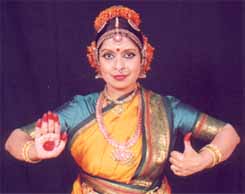 |
| Bharata Natyam artist Dr. Malati Agniswaran depicting Murukan. The right hand shows abhaya mudra through the pataka hasta whereas the left hand show vel through the shikhara hasta. |
sarana step) and holding at the same time patāka.
Prof. (Smt.) Malati Agniswaran
Qualifications: B.A. (Hons.) German, B.F.A., M.F.A. PH.D. (Dance); diplomas
in Saiva Siddhanta, Comparative Mythology and Theatre Arts.
Designation: Reader & Head of Dept. of Bharatanatyam, Nalanda Nritya Kala Mahavidyalaya, Mumbai University.
|
Official address: |
Residential Address: |
